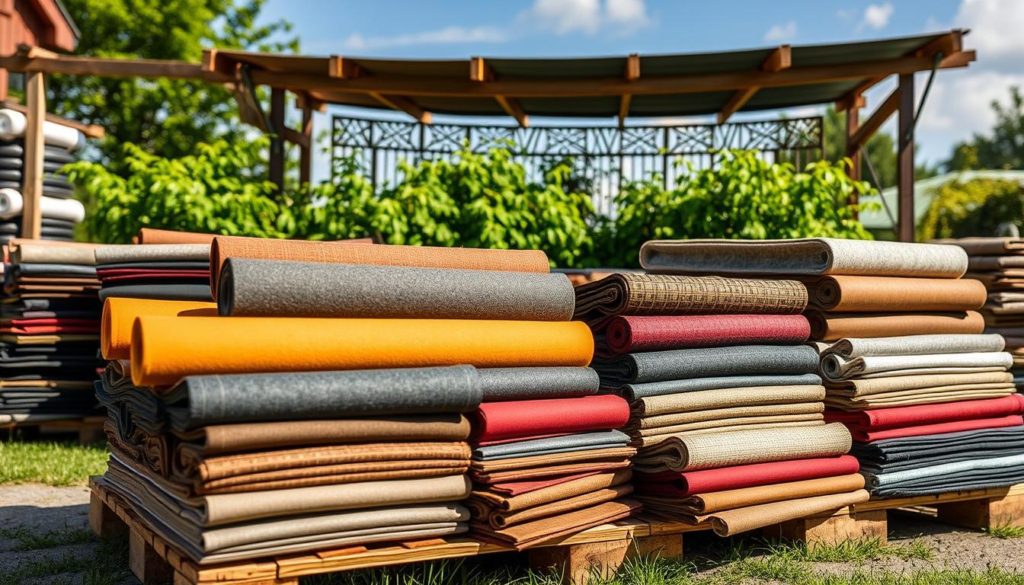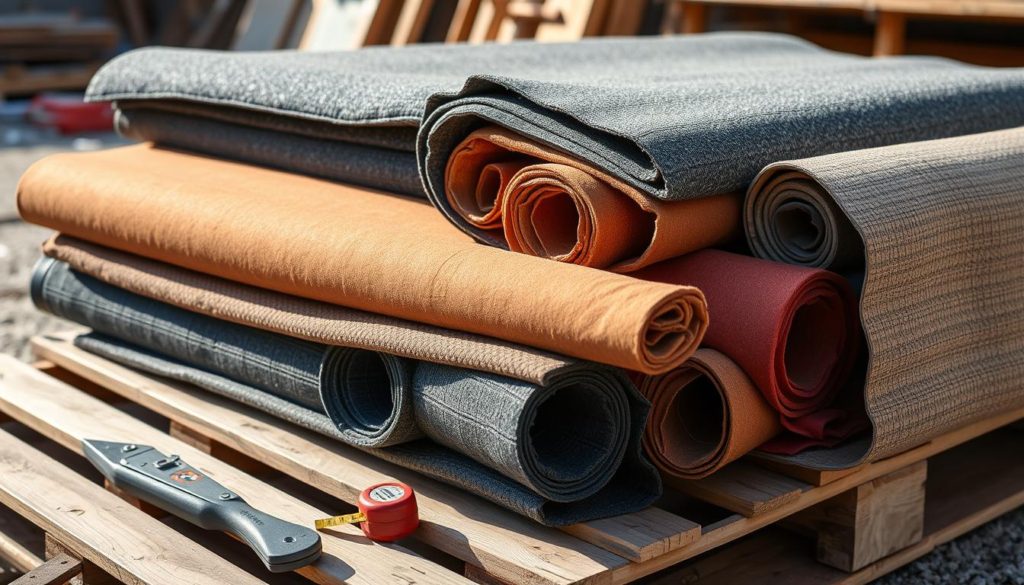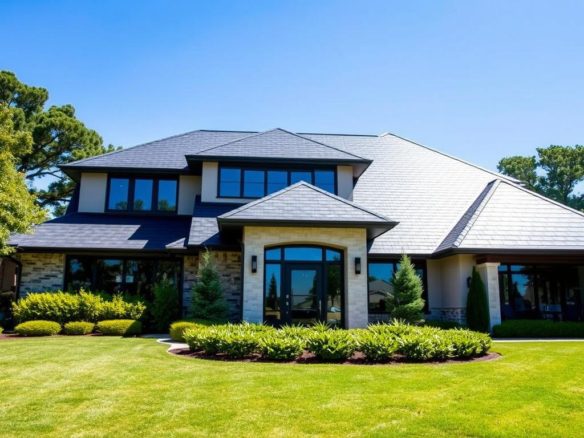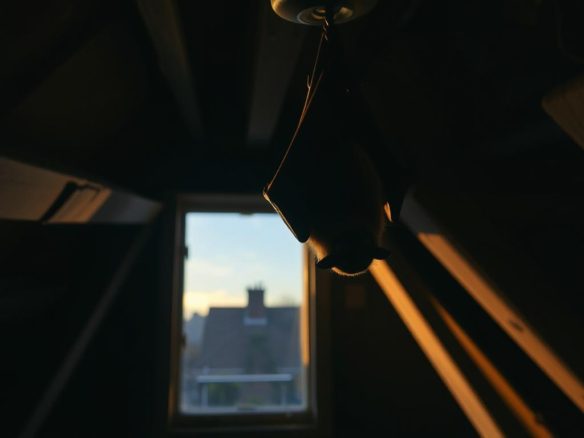In the United States, 80% of construction projects use finished roofing rolls. They are known for their durability and cost-effectiveness. It’s important to look at the different finished roll roofing options available. These rolls are a favorite for many, thanks to their benefits for builders and homeowners.
Key Takeaways
- Finished roofing rolls offer exceptional durability and cost-effectiveness.
- There are various types of roofing that come in finished rolls, including modified bitumen and EPDM rubber rolls.
- Finished roll roofing options provide a range of benefits, including ease of installation and maintenance.
- Choosing the right finished roofing roll option depends on the specific needs of the project.
- Finished roofing rolls are a popular choice for construction projects in the United States.
- Understanding the different types of finished roll roofing options is key to making a good choice.
Understanding What Kind of Roofing Comes in Finished Rolls
There are many types of roofing in finished rolls to choose from. These materials are easy to use and cover a roof well. Modified bitumen rolls are very durable and stand up to the weather.
EPDM rubber rolls are flexible and simple to put on. They’re perfect for those who want a roof that’s easy to care for. TPO membrane rolls are also popular. They’re durable and help save energy, making them a smart choice for many.
Finished roll roofing has many benefits. It’s easy to install, lasts a long time, and resists weather damage. You can find them in many materials, like synthetic and natural ones. Here are some common types:
- Modified bitumen rolls
- EPDM rubber rolls
- TPO membrane rolls
These roofing options are energy-efficient, durable, and need little upkeep. They also come at different prices, which is good for those watching their budget. Finished roll roofing is a smart pick for a hassle-free and efficient roof.
Key Benefits of Finished Roll Roofing Materials
Finished roll roofing materials are a top pick for many. They last a long time with a little care. Here are some key benefits:
- Cost-effectiveness: They’re easy to put up, saving on labor costs.
- Weather resistance: They stand up well to wind, rain, and heat, fitting many climates.
- Low maintenance: They don’t crack or get damaged easily, so they need little upkeep.
Durable finished roll roofing solutions protect homes and buildings for years. They’re a favorite for many projects.
Finished roll roofing is a smart choice for a dependable and affordable roof. It offers a long-lasting and easy-to-care-for option for homeowners and builders.
Popular Materials Used in Finished Roofing Rolls
There are many materials used in finished roll roofing, each with its own benefits. Synthetic materials like PVC and TPO are popular because they last long and resist weather. These materials are favorites in the roofing industry.
Some of the key materials used in finished roofing rolls include:
- Synthetic materials, such as PVC and TPO, which offer excellent durability and resistance to weathering
- Natural materials, such as rubber and asphalt, which provide a more traditional look and feel
- Composite options, which combine different materials to offer a balance of durability and cost-effectiveness
These materials cater to different needs, making installation easy, maintenance low, and energy use efficient. They come in various styles and colors, helping homeowners find the perfect fit for their homes.
The cost and durability of finished roll roofing materials vary. But, with the right installation and care, they can last for decades. They ensure homes and buildings stay weather-tight.
| Material | Durability | Cost |
|---|---|---|
| PVC | High | Medium |
| TPO | High | Medium |
| Rubber | Medium | Low |
| Asphalt | Medium | Low |
Durability and Lifespan Expectations
Homeowners and builders often ask about the durability of durable finished roll roofing solutions. The lifespan of a finished roll roofing material varies. It depends on the material type, installation quality, and maintenance. On average, it can last 15-20 years, but some materials can last longer with proper care.
The durability of finished roll roofing options is influenced by several factors. The quality of materials, the installer’s skill, and maintenance level all play a role. For instance, regular checks and repairs can extend its life. Neglecting maintenance can shorten its lifespan.
Here are some general guidelines for the lifespan of different finished roll roofing options:
- EPDM rubber rolls: 15-20 years
- Modified bitumen rolls: 15-25 years
- TPO membrane rolls: 20-30 years
Keep in mind, these are general estimates. The actual lifespan can vary based on the installation conditions. Choosing durable finished roll roofing solutions and maintaining them properly can ensure a long-lasting roof.

In conclusion, the durability and lifespan of finished roll roofing materials are key considerations for new roof installations. Understanding the factors that affect lifespan and selecting durable finished roll roofing solutions helps make informed decisions. This way, homeowners and builders can enjoy a reliable roof for many years.
| Material | Lifespan | Maintenance Requirements |
|---|---|---|
| EPDM rubber rolls | 15-20 years | Regular inspections and repairs |
| Modified bitumen rolls | 15-25 years | Periodic cleaning and sealing |
| TPO membrane rolls | 20-30 years | Regular inspections and repairs |
Cost Analysis and Budget Considerations
When looking at finished roll roofing, cost is a big factor. Prices vary based on material, size, and how well it’s installed. Materials can cost between $0.50 and $5.00 per square foot. Installation adds another $1.00 to $3.00 per square foot, for labor and equipment.
The type of material used greatly affects the cost. Common materials include synthetic rubber, thermoplastic olefin (TPO), and polyvinyl chloride (PVC). Synthetic rubber is cheaper, while TPO is pricier.
Material Costs
- Synthetic rubber: $0.50 to $2.00 per square foot
- Thermoplastic olefin (TPO): $1.00 to $3.00 per square foot
- Polyvinyl chloride (PVC): $1.50 to $4.00 per square foot
Installation Expenses
Installation costs also vary. They depend on the job’s complexity and location. On average, it’s $1.00 to $3.00 per square foot. Some contractors charge more for harder jobs or those needing special equipment.
Long-term Value Assessment
It’s important to think about the long-term value of finished roll roofing. High-quality products last longer and save money over time. They resist weather and damage well. Choosing a good material means less maintenance, better energy use, and a nicer look.
Installation Methods and Requirements
Installing finished roll roofing materials needs careful planning. You must follow the manufacturer’s guide and local building codes. First, prepare the roof surface. Then, apply adhesive and roll out the material.
It’s important to align and secure the material well. This ensures a tight seal against water.
There are several types of finished roll roofing, like modified bitumen, EPDM rubber, and TPO membrane. Each type has its own installation steps. For instance, modified bitumen rolls need adhesive on the roof first. EPDM rubber rolls can be installed in different ways, including with fasteners or adhesive.
Here are some key things to remember when installing finished roll roofing materials:
- Make sure the roof is clean and dry before starting
- Use the right amount of adhesive on the roof
- Roll out the material in the right direction for alignment
- Secure the material with the recommended fastening method
By following these steps and picking the right roofing option, you can have a successful installation. This will give you a durable and lasting roof.
| Finished Roll Roofing Option | Installation Method | Adhesive Requirements |
|---|---|---|
| Modified Bitumen Rolls | Mechanical fastening or fully adhered system | Layer of adhesive required |
| EPDM Rubber Rolls | Mechanical fastening, fully adhered system, or ballasted system | No adhesive required |
| TPO Membrane Rolls | Mechanical fastening or fully adhered system | Layer of adhesive required |
Weather Resistance and Climate Compatibility
Finished roll roofing materials must handle different weather conditions well. They are made to last long and protect against the elements. In hot areas, they need to fight off UV rays and extreme heat.
In cold places, they face challenges like freezing and ice. Moisture resistance features are key, as they must handle heavy rain and floods. Here are important points for weather and climate:
- UV resistance: The material’s ability to withstand ultraviolet radiation, which can cause degradation and damage.
- Temperature extremes: The material’s ability to perform in both hot and cold temperatures, without losing its integrity.
- Moisture resistance: The material’s ability to withstand heavy rainfall, flooding, and other moisture-related events.
By thinking about these points, people can pick durable roll roofing that lasts.
| Material | UV Resistance | Temperature Extremes | Moisture Resistance |
|---|---|---|---|
| EPDM Rubber | Excellent | Good | Excellent |
| TPO Membrane | Good | Excellent | Good |
| Modified Bitumen | Fair | Good | Fair |
Maintenance Tips and Best Practices
Regular maintenance is key to making finished roll roofing materials last longer. It’s important to check the roof often to catch problems early. Also, cleaning the roof regularly helps prevent debris from damaging the material.
Choosing the right finished roll roofing options means knowing how to take care of them. Some materials need more checks or special cleaners. By following the maker’s advice and staying ahead of maintenance, you can keep your roof in top shape for many years.

Here are some important tips for finished roll roofing materials:
- Regularly inspect the roof for signs of damage or wear
- Clean the roof surface to prevent debris buildup
- Make repairs promptly to prevent further damage
- Apply protective coatings or sealants to protect the material from weathering
By following these tips, homeowners can make their finished roll roofing materials last longer. This ensures their roof stays in great shape for years.
| Maintenance Task | Frequency | Importance |
|---|---|---|
| Regular Inspections | Every 6-12 months | High |
| Cleaning | Every 1-2 years | Medium |
| Repairs | As needed | High |
Environmental Impact and Sustainability Features
When we talk about finished roll roofing, we must think about the environment. Top products aim to be eco-friendly without sacrificing durability. They are made from various materials, each with its own environmental effects.
The way these materials are made can harm the planet. But, many makers are changing their ways. They now use recycled stuff, cutting down on waste and energy use.
Energy Efficiency Ratings
Energy use is key in finished roll roofing. The best products help buildings use less energy. They keep buildings cool in summer and warm in winter, cutting down on heating and cooling needs.
Recyclability Options
When these materials wear out, they can be recycled. This cuts down on waste and saves raw materials. Many makers have recycling programs, making it easy to get rid of old roofing responsibly.
Choosing top-rated finished roll roofing helps the environment and saves money. These materials are popular for their green features. They’re a smart choice for anyone wanting to lessen their environmental impact.
| Material | Energy Efficiency Rating | Recyclability |
|---|---|---|
| EPDM Rubber | High | Yes |
| TPO Membrane | Medium | Yes |
| Modified Bitumen | Low | No |
Conclusion: Making Your Final Selection
Finished roll roofing is a great choice for homes and businesses. It’s easy to install and comes in many materials. Think about what each material offers, its cost, and how it affects the environment.
Choosing between modified bitumen, EPDM rubber, or TPO membrane is important. Make sure the finished roll roofing fits your climate, budget, and needs. A professional roofing contractor can help you choose the best option and ensure it’s installed right.
By considering all the points in this article, you can pick the finished roll roofing that works best for you. It will protect your property, save energy, and look good. Choosing the right roofing material is key to keeping your place safe and valuable.
FAQ
What types of roofing materials come in finished rolls?
Common roofing materials in finished rolls include modified bitumen, EPDM rubber, and TPO membrane.
What are the key benefits of using finished roll roofing materials?
Finished roll roofing materials are durable and cost-effective. They resist weather well and are easy to install.
What are the popular materials used in finished roofing rolls?
You can find finished roofing rolls in many materials. This includes synthetic options like PVC and TPO, natural materials like rubber and asphalt, and composite materials.
How long can I expect a finished roll roofing material to last?
A finished roll roofing material usually lasts 15-20 years. The exact lifespan depends on the material, how well it’s installed, and maintenance.
How do I determine the budget and cost considerations for finished roll roofing?
The cost of finished roll roofing depends on the material, size, and installation. Material prices range from $0.50 to $5.00 per square foot. Installation can add $1.00 to $3.00 per square foot.
What are the installation requirements for finished roll roofing materials?
Installing finished roll roofing involves preparing the roof, applying adhesive, and rolling out the material. It’s important to align and secure it properly for a watertight seal. Follow the manufacturer’s instructions and local building codes.
How do finished roll roofing materials perform in different weather conditions?
Finished roll roofing materials are made to withstand various weather conditions. They resist UV radiation, extreme temperatures, and heavy rainfall.
What maintenance tips should I follow for finished roll roofing?
Regular inspections, cleaning, and prompt repairs are key to maintaining finished roll roofing. Using protective coatings and sealants can also help.
How eco-friendly are finished roll roofing materials?
Many finished roll roofing materials are energy-efficient and recyclable. Consider their environmental impact, including production and waste, when choosing a roofing option.







Join The Discussion